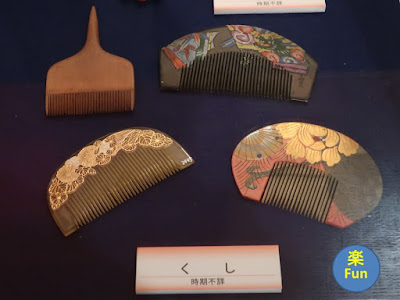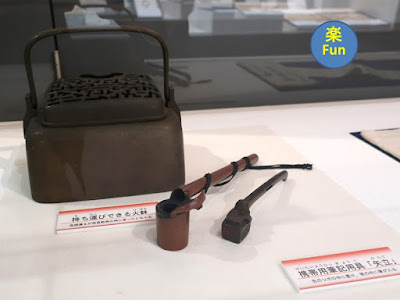Takatsuki is located almost in the middle of Kyoto and Osaka, and it was a castle city of the medium daimyo lord, Nagai clan. The museum was built
in the ruined Takatsuki castle. The exhibition room is divided into five areas - - (1) Takatsuki castle and samurai, (2) Lives in the castle city, (3) Saigoku-kaido(highway)
and Akutagawa-shuku(post town), (4) Yodo River and water
transportation, and (5) Local industry. The history since the Edo period (1603—1868) is exhibited very well.
My favorite is the portable sake(alcohol) utensils of Mr. Fujii who was a chic cultural person. Those utensils have distinctive taste. We also find fun of
ordinary people easily here.
京都と大阪のほぼ中間に位置する高槻市は、永井氏3万六千万石の城下町であった。旧城内にある博物館は、高槻城と人、城下の暮らし、西国街道と芥川宿、淀川と舟運、人々の生業と営みの5つのコーナーがあり、江戸時代以降の歴史が丁寧に展示されている。
逸品は、藤井竹外の酒器。文化人のセンスの良さを感じる味わいのあるものだ。その他、庶民の楽しみも諸所に発見できる。 |
Takatuski castle is introduced in this area. Model of the castle
and actual building stones are exhibited. 高槻城を紹介するコーナー、模型や実物の石材などが展示されている。
|
Lives in the castle city、城下の暮らし
 |
Picnic and festival, which are very good
entertainment for people, took root in the Edo period. People were permitted to
enter the castle for the Bon dance in July, because there were no parks
back then. They delighted definitely.
江戸時代には、四季折々を楽しむ花見などの「遊山」や祭礼が定着した。7月の盆踊りでは町民も城内に入ることが許されたという。城下には広場がなかったというので、みんな嬉しかったろう。
|
 |
People enjoyed harvesting Matsutake
mushrooms which Japanese like so much. 松茸狩りの様子。いやあ、賑やかだ。
|
 |
| Plain figure of the city、城下の町並み |
 |
Accessories; ornamental hairpins
装飾具の簪(かんざし)。美しい。
|
 |
| Combs 櫛、こちらも美しい |
 |
Tools for hairdressing “Kougai”
髪を手入れする笄(こうがい)
|
 |
| Daily utensils、日々の道具 |
 |
Exhibits about learning and playing; articles
are shown with historical documents. It’s very understandable. 「学びと遊び」のコーナー。資料とともに丁寧に整理されている。
|
 |
Chikugai Fuji’s favorites; he was the poet of
Chinese poem who was born around 200 years ago. I love the shell shaped sake cup made
of wood.
漢詩人・藤井竹外(ちくがい1807-1868)愛用品。木製の貝殻型の盃が素敵だ。
|
Saigoku-kaido(highway) and Akutagawa-shuku(post town)、西国街道と芥川宿
 |
Akutagawa-shuku was a post town in
Takatsuki which was on the Saigoku-kaido. Travelers to Ise or Konpira walked
the road.
高槻にあった宿場町、芥川宿。京と神戸を直接結ぶ西国街道上にあった。伊勢や金比羅へのお参りの人々も行き交った。
|
 |
Travel diary to Konpira (1841): Ms.
Igarashi went to Konpira Shrine which is 250 km away. She enjoyed sightseeing
on the way.
金比羅詣の旅日記(1841)。五十嵐とよさんが、250km離れた金比羅に詣でた時の日記。寄り道しながら物見遊山を楽しんだようだ。
|
 |
Travel record to Ise; people established Kou
groups and dispatched the delegate to Ise Shrine every year. They had a
party when the delegate left and the menu was exhibited.
伊勢詣の記録。講を作って資金を出し合い、毎年代参者を伊勢神宮に送り出した。出発の時に、宴会を開いたが、そのメニューが記載されている。
|
 |
The menu of the party (1852); there were
many kinds of dishes. The main dish seemed to be a grilled tai fish.
宴会の献立(1852年);種類が多い。鯛の焼き物がメインディッシュのようだ。
|
Traffic by Yodo River、淀川と舟運
 |
These
dishes of Kurawanka-bune, which served food and drinks to Sanjyukoku-bune, were
found at the bottom of Yodo River. It is written that meal charges were decided
by the number of plates, so some travelers threw them away to the river.
Reference:Hirakata-shukuKagiya Museum which is opposite side of Yodo River.
淀川の底から見つかったくらかんか舟の茶碗。くらわんか舟は三十石舟に飲食物を売る小舟だ。茶碗の数で支払いをしていたため、茶碗を川に投げるものもいたとか。くらわんか舟の発祥は、高槻側・柱本とのことだ。
参考:枚方宿鍵屋資料館 (淀川の対岸)
|
Industry and livelihood、人々の生業と営み
 |
Kosobe-ware were made in the 19th
century in Takatsuki. 江戸後期から明治末期にかけて、古曽部で焼かれた古曽部焼。茶碗が多いようだ。
|
 |
| Trial fitting area for children. 子ども体験コーナーで試着を楽しめる。 |
 |
| Ruined castle park of Takatsuki、高槻城跡の公園 |
14 funs(楽fun)were found. Visited in December, 2018
Website:http://www.city.takatsuki.osaka.jp/rekishi_kanko/rekishi/1378689373722.html
(Very informative but basically Japanese. English page is translated by machine.)
, accessed in February, 2020
Previous post (Old customs of the neighboring city):
My home town, Ibaraki -Customs- (Part2) わがまち茨木 -風習編- その2
Next post (Museum in the same city):
Takatsuki history and folklore museum 高槻市立歴史民俗資料館







Comments
Post a Comment